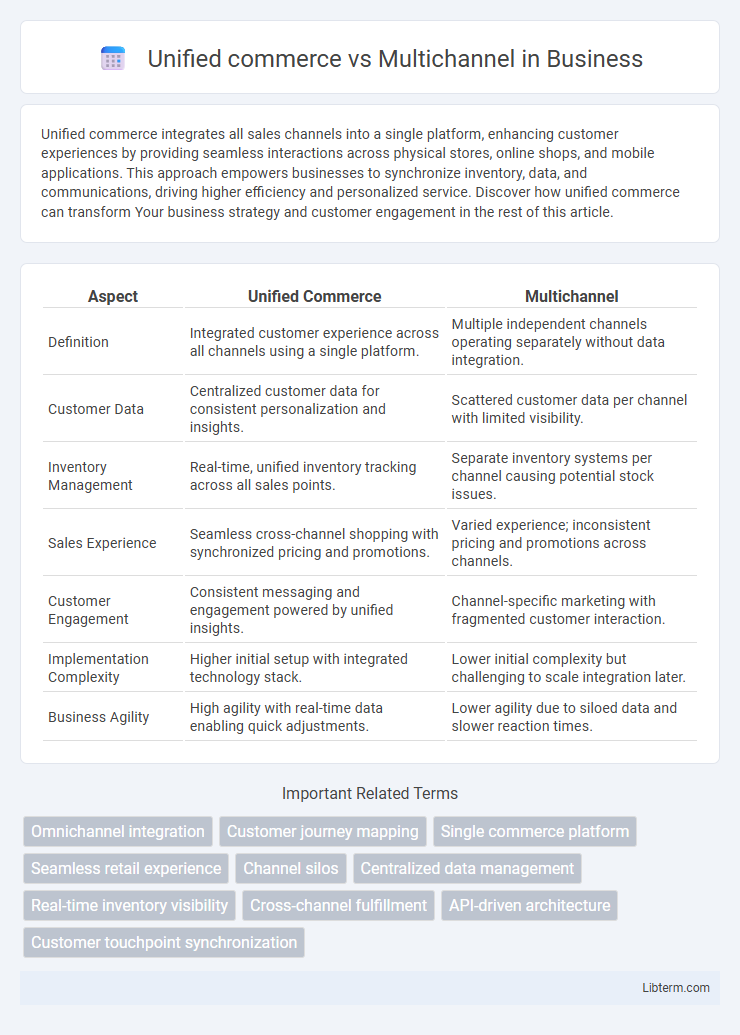Unified commerce integrates all sales channels into a single platform, enhancing customer experiences by providing seamless interactions across physical stores, online shops, and mobile applications. This approach empowers businesses to synchronize inventory, data, and communications, driving higher efficiency and personalized service. Discover how unified commerce can transform Your business strategy and customer engagement in the rest of this article.
Table of Comparison
| Aspect | Unified Commerce | Multichannel |
|---|---|---|
| Definition | Integrated customer experience across all channels using a single platform. | Multiple independent channels operating separately without data integration. |
| Customer Data | Centralized customer data for consistent personalization and insights. | Scattered customer data per channel with limited visibility. |
| Inventory Management | Real-time, unified inventory tracking across all sales points. | Separate inventory systems per channel causing potential stock issues. |
| Sales Experience | Seamless cross-channel shopping with synchronized pricing and promotions. | Varied experience; inconsistent pricing and promotions across channels. |
| Customer Engagement | Consistent messaging and engagement powered by unified insights. | Channel-specific marketing with fragmented customer interaction. |
| Implementation Complexity | Higher initial setup with integrated technology stack. | Lower initial complexity but challenging to scale integration later. |
| Business Agility | High agility with real-time data enabling quick adjustments. | Lower agility due to siloed data and slower reaction times. |
Introduction to Unified Commerce and Multichannel
Unified commerce integrates all customer touchpoints and backend systems into a single platform, offering seamless, consistent shopping experiences across online, mobile, and physical stores. Multichannel retail involves using multiple separate sales channels, such as brick-and-mortar, e-commerce sites, and social media, but often lacks centralized data and coordination. The key distinction lies in unified commerce's real-time data synchronization and holistic approach, enhancing operational efficiency and personalized customer engagement.
Defining Unified Commerce: Key Features
Unified commerce integrates all sales channels and customer touchpoints into a single, seamless platform, enhancing data consistency and customer experience. Core features include real-time inventory visibility, centralized customer profiles, and synchronized order management across online, in-store, and mobile channels. This approach enables businesses to deliver personalized interactions and efficient service by breaking down silos between sales channels.
Understanding Multichannel Commerce
Multichannel commerce involves selling products across multiple platforms, such as physical stores, online marketplaces, and social media channels, each operating independently with separate inventory and customer data. This approach can lead to fragmented customer experiences and challenges in inventory management due to lack of integration among channels. Understanding multichannel commerce highlights the need for seamless coordination and consistent branding to improve customer engagement and operational efficiency.
Core Differences Between Unified Commerce and Multichannel
Unified commerce integrates all sales channels and customer data into a single platform, providing a seamless and consistent shopping experience across online, in-store, and mobile touchpoints. Multichannel retail operates distinct channels independently, often resulting in fragmented customer experiences and separate inventory management. The core difference lies in unified commerce's holistic approach to real-time data synchronization and personalized engagement, while multichannel prioritizes channel proliferation without centralized coordination.
Customer Experience: Unified Commerce vs Multichannel
Unified commerce offers a seamless customer experience by integrating all sales channels into a single platform, enabling consistent interactions and real-time data access. Multichannel systems operate independently across channels, often leading to fragmented customer journeys and delayed information updates. Unified commerce enhances personalization and fulfillment efficiency, significantly improving overall customer satisfaction compared to multichannel approaches.
Technology Integration and Data Management
Unified commerce integrates technology systems and data into a centralized platform, enabling real-time inventory updates, seamless customer experiences, and unified analytics across all sales channels. Multichannel approaches operate separate systems for each channel, causing fragmented data silos and inconsistent customer information management. Advanced API-driven platforms and cloud-based solutions are key enablers of unified commerce, supporting synchronized order processing and comprehensive customer profiles.
Operational Efficiency Comparison
Unified commerce integrates all sales channels into a single platform, streamlining inventory management, order processing, and customer data, which enhances operational efficiency by reducing redundancies and errors. Multichannel systems operate separate channels independently, often leading to fragmented inventory and inconsistent customer experiences, increasing the complexity and cost of operations. Retailers adopting unified commerce report faster order fulfillment, improved supply chain coordination, and better resource allocation, directly impacting overall operational performance.
Scalability and Future-Proofing
Unified commerce offers superior scalability by integrating all customer touchpoints and inventory systems into a single platform, enabling seamless expansion across channels without data silos. Multichannel approaches often face challenges in future-proofing due to disjointed systems that complicate real-time inventory updates and customer experience consistency. Businesses opting for unified commerce can better adapt to evolving market demands and technological advancements, ensuring long-term growth and operational efficiency.
Challenges and Limitations of Each Approach
Unified commerce faces challenges in integrating diverse systems into a seamless platform, often requiring substantial investment and technical expertise to ensure real-time data synchronization across all channels. Multichannel retail suffers from data silos and inconsistent customer experiences due to disparate systems operating independently, which limits the ability to provide a cohesive shopping journey. Both approaches struggle with scalability and maintaining up-to-date inventory visibility, but unified commerce offers better potential for centralized analytics and personalized marketing despite its higher complexity.
Choosing the Right Strategy for Your Business
Unified commerce integrates all sales channels into a single platform, providing a seamless customer experience and real-time inventory management, while multichannel operates each channel independently with separate data systems. Choosing the right strategy depends on your business size, customer behavior, and operational complexity; unified commerce suits businesses seeking streamlined operations and consistent branding across touchpoints. Analyze factors like sales volume, customer engagement, and IT infrastructure to determine whether unified commerce's centralized control or multichannel's diverse approach aligns best with your growth objectives.
Unified commerce Infographic

 libterm.com
libterm.com